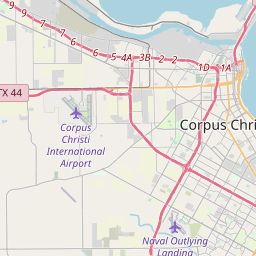Early History of Port of Corpus Christi
Historical marker location:






Protected by offshore islands, the shallow waters of Corpus Christi Bay were a haven for smugglers before the Texas Revolution (1836). Commercial activity began when Henry L. Kinney (1814-1860) opened a trading post here about 1838. After the Mexican War (1846-1848), Corpus Christi became a departure point for the California Gold Rush (1849) and a main stop on the route between San Antonio and the Rio Grande Valley.
In 1854 the city authorized dredging operations to make the harbor accessible to deep water vessels. In 1857 a circuitous 32-mile long channel was opened from Corpus Christi Bay to Aransas Pass. Blockaded by Federal ships during the Civil War (1861-1865), Corpus Christi remained a major port for Confederate trade with Mexico until the harbor was captured in 1864. The ship channel was widened and deepened in 1874.
Elihu Harrison Ropes of New Jersey came to Corpus Christi in 1890 with ambitious plans for development of the city and port. Using a steam dredge, he began digging a 14-mile long, 15-foot deep pass across Mustang Island. The "Ropes Boom" collapsed in the Panic of 1893, but Ropes' efforts laid a foundation for the opening of the Port of Corpus Christi on Sept. 15, 1926, and its success as one of the nation's largest seaports.
(1977)
As one of the most visible programs of the Texas Historical Commission (THC), historical markers commemorate diverse topics in Texas history, including: the history and architecture of houses, commercial and public buildings, religious congregations, and military sites; events that changed the course of local and state history; and individuals who have made lasting contributions to the state, community organizations, and businesses.
Texas is also home to the world's largest honky-tonk, Billy Bob's Texas in Fort Worth. The venue covers three acres and can hold up to 6,000 people.
In 1828, the Mexican government granted land to Colonel Henry Lawrence Kinney, an American entrepreneur, who founded the trading post of Kinney's Trading Post near the Nueces River. This marked the beginning of Anglo settlement in the area. Nueces County was officially established in 1846, following the Texas Revolution and subsequent annexation of Texas by the United States.
Throughout the 19th century, Nueces County played a significant role in Texas' development. The town of Corpus Christi, which served as the county seat, became an important regional trade center due to its proximity to the Gulf of Mexico. The county flourished as a shipping hub for livestock, cotton, and other agricultural goods.
The county's history was greatly influenced by its participation in several military conflicts. During the American Civil War, Corpus Christi served as a center for Confederate forces, and the county witnessed both Union and Confederate occupation. Additionally, the county played an important role during World War II, with Corpus Christi becoming a major training center for Navy pilots.
In recent times, Nueces County has continued to grow and evolve. The county's economy has diversified, with tourism, oil and gas, and the military being major contributors. The region boasts numerous attractions, including beautiful coastal beaches, cultural sites, and a vibrant culinary scene. Today, Nueces County remains an important and thriving part of Texas' history and economy.
Nueces County Timeline
This timeline provides a condensed summary of the historical journey of Nueces County, Texas.
- 1836 - Nueces County is established as one of the original counties in the Republic of Texas.
- 1845 - Texas becomes a state of the United States, and Nueces County remains part of the state.
- 1848 - The county seat is established in Corpus Christi.
- 1850 - The population of Nueces County reaches 756 residents.
- 1852 - The Corpus Christi Cathedral is constructed, becoming a significant landmark in the county.
- 1872 - The railroad reaches Nueces County, leading to increased economic development and population growth.
- 1875 - The Nueces County Courthouse, built in the Renaissance Revival style, is completed.
- 1900 - A devastating hurricane strikes the county, causing significant damage and loss of life.
- 1914 - The Port of Corpus Christi is established, becoming a major hub for trade and industry.
- 1931 - The Nueces County Courthouse is expanded and remodeled to its current appearance.
- 1940 - Nueces County experiences a population boom, with the county's residents totaling over 101,000.
- 1987 - Hurricane Gilbert causes widespread destruction in Nueces County and the surrounding areas.
- Present - Nueces County continues to be a thriving center for commerce, industry, and tourism.